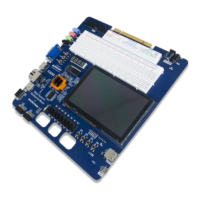22 | ni.com | NI Digital System Development Board User Manual
Figure 5. PS/2 Device-to-host Timing Diagram
The clock and data signals are only driven when data transfers occur; otherwise, they are held in
the idle state at logic '1'. This requires that when the PS/2 signals are used in a design, internal
pull-ups must be enabled in the FPGA on the data and clock pins. The clock signal is normally
driven by the device, but may be held low by the host in special cases. The timings define signal
requirements for mouse-to-host communications and bidirectional keyboard communications. A
PS/2 interface circuit can be implemented in the FPGA to create a keyboard or mouse interface.
When a keyboard or mouse is connected to the board, a self-test passed command (0xAA) is sent
to the host. After this, commands may be issued to the device. Since both the keyboard and the
mouse use the same PS/2 port, one can tell the type of device connected using the device ID.
This ID can be read by issuing a Read ID command (0xF2). Also, a mouse sends its ID (0x00)
right after the self-test passed command, which distinguishes it from a keyboard.
Keyboard
PS/2 uses open-collector drivers so the keyboard, or an attached host device, can drive the
two-wire bus (if the host device will not send data to the keyboard, then the host can use
input-only ports).
PS/2-style keyboards use scan codes to communicate key press data. Each key is assigned a code
that is sent whenever the key is pressed. If the key is held down, the scan code will be sent
repeatedly about once every 100ms. When a key is released, an F0 key-up code is sent, followed
by the scan code of the released key. If a key can be shifted to produce a new character (like a
capital letter), then a shift character is sent in addition to the scan code, and the host must
determine which ASCII character to use. Some keys, called extended keys, send an E0 ahead of
the scan code (and they may send more than one scan code). When an extended key is released,
an E0 F0 key-up code is sent, followed by the scan code. Scan codes for most keys are shown in
Figure 6.

